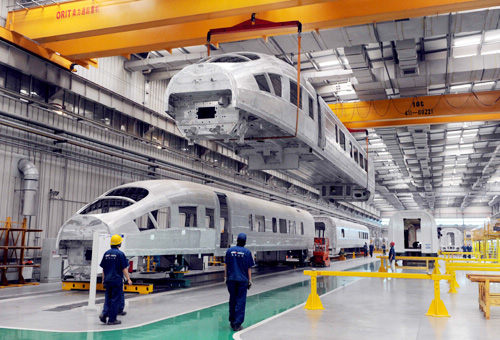|
 |
|
ON THE FAST TRACK: A production line in Tangshan Railway Vehicle Co. Ltd. In 2008, the first high-speed train independently developed and made in China rolled off the production line (WU HONGDAO) |
At the beginning of 2006, at the National Science and Technology Conference, the Central Committee of the Communist Party of China and the State Council published the decision on implementing the guidelines and enhancing the country's indigenous innovation capacity.
After GDP growth soared near 10 percent for 30 years, foreign media hailed the country's move to focus more on the composition and quality of GDP in addition to its growth rate.
To implement the guidelines, the government has enacted many detailed implementation rules and promulgated relevant policies. They cover a wide range of areas related to science and technology and innovation such as taxation, financing, education, and innovation platforms.
After innovation was declared a national strategy, it quickly became a social consensus and engine for growth.
Official statistics show that government expenditure on science and technology has grown continuously, maintaining an average annual growth rate of 25.2 percent from 2006 to 2010, and reaching 861 billion yuan ($135 billion), or 1.83 percent of the GDP, last year. Statistics from the Organization for Economic Cooperation and Development indicated that China's research and development expenditure is second only to that of the United States.
Xu Heping, Director of the Research Department of the Ministry of Science and Technology, projected that after adjusting for purchasing power parity, China's research and development spending will be more or less equal to that of the United States in 2015.
In 2011, China granted 172,000 patents of invention, up 27.4 percent from the previous year, ranking third in the world, according to the Ministry of Science and Technology. The nation also ranked second in terms of the number of published papers, and seventh in terms of the number of science and technology papers cited, as shown by the Science Citation Index.
According to Beijing-based Science and Technology Daily, China ranks second in the world in terms of value added in the hi-tech industry, the first in the export volume of hi-tech products, and second in application for patent of invention.
Enterprise-driven innovation
At the recent national science and technology innovation conference, Premier Wen Jiabao said that the most important task of reforming the science and technology system is integrating science and technology with economy, as well as strengthening enterprises' innovation capacity, which is of strategic importance to the long-term development of the country.
Now the most pressing issue for China is to set up an innovative industry research and development system mainly driven by enterprises, said Wan Gang, Minister of Science and Technology.
In his eyes, only by strengthening enterprises' role in scientific and technological innovation can the overall effectiveness of the innovation system be enhanced.
That enterprises are the mainstay of technological innovation is a widely accepted idea in many countries, yet in China, the concept is far from being well-established, said Liu Li, a reporter from Science and Technology Daily, who covered the national science and technology innovation conference held on July 6.
"China had been under a planned economy for decades. The government's industrial management departments took on many responsibilities that it should not shoulder, reducing enterprises to virtually processing workshops. So, over time, enterprises have lost the momentum and ability to innovate," Liu said.
| 